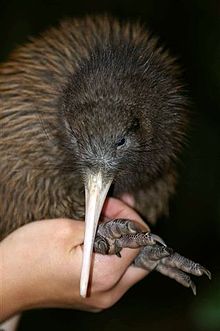- Fauna of New Zealand
-
The animals of New Zealand have a particularly interesting history because, before the arrival of humans, less than 900 years ago, the country was completely free of mammals, except those that could swim there (seals, sea lions, and, off-shore, whales) or fly there (bats). This meant that all the ecological niches occupied by mammals elsewhere were occupied by either insects or birds, leading to an unusually large number of flightless birds, including the Kiwi, the Moa, and the Kakapo. Because of the lack of predators even the bats spend most of their time on the ground. There are also about 60 species of lizard (30 each of gecko and skink), and four species of frog (all rare and endangered).
Humans first arrived via the Pacific islands, in several waves at some time before 1300,[1] bringing with them the Polynesian Rat (Kiore) and the domesticated dog. Europeans later brought pigs, ferrets, stoats, mice, rats, dogs, cats, sheep, cattle, and many other mammals. Of these, the rats, ferrets, cats, stoats and dogs have all seriously impacted the New Zealand fauna, driving many species to extinction. Possums were introduced from Australia for a fur industry, and deer from Europe as game animals, both seriously damaging the forest habitat of many birds.
In recent years, successful efforts have been made to remove possums, rats, ferrets, and other mammals from many offshore islands, large and small, in an effort to return these places to something more closely resembling their original state. An estimated 30 tons of dead possums were removed from Kapiti Island, for example. Similarly, efforts are being made to control such species in selected locations on the mainland. In a further step, in certain mainland reserves mammals are being completely eliminated within predator-proof fences creating ecological islands. Examples are the Karori Wildlife Sanctuary in Wellington City, from which about a ton of dead possums was removed after the installation of a mammal-proof fence, and the Maungatautari Restoration Project.
See also
- Biodiversity of New Zealand
- Birds of New Zealand
- Butterflies of New Zealand
- Dinosaurs of New Zealand
- Frogs of New Zealand
- Geckos of New Zealand
- Mammals of New Zealand
- Spiders of New Zealand
- List of crabs of New Zealand
- List of non-marine molluscs of New Zealand
References
- ^ New Scientist Webpage: Rat remains help date New Zealand's colonisation. Accessed 2008-06-23
External links
- Native animals of New Zealand - Department of Conservation.
- Animals of New Zealand - children's learning aid.
Fauna of Oceania Sovereign states Dependencies and
other territories- American Samoa
- Christmas Island
- Cocos (Keeling) Islands
- Cook Islands
- Easter Island
- French Polynesia
- Guam
- Hawaii
- New Caledonia
- Niue
- Norfolk Island
- Northern Mariana Islands
- Pitcairn Islands
- Tokelau
- Wallis and Futuna
Categories:
Wikimedia Foundation. 2010.

